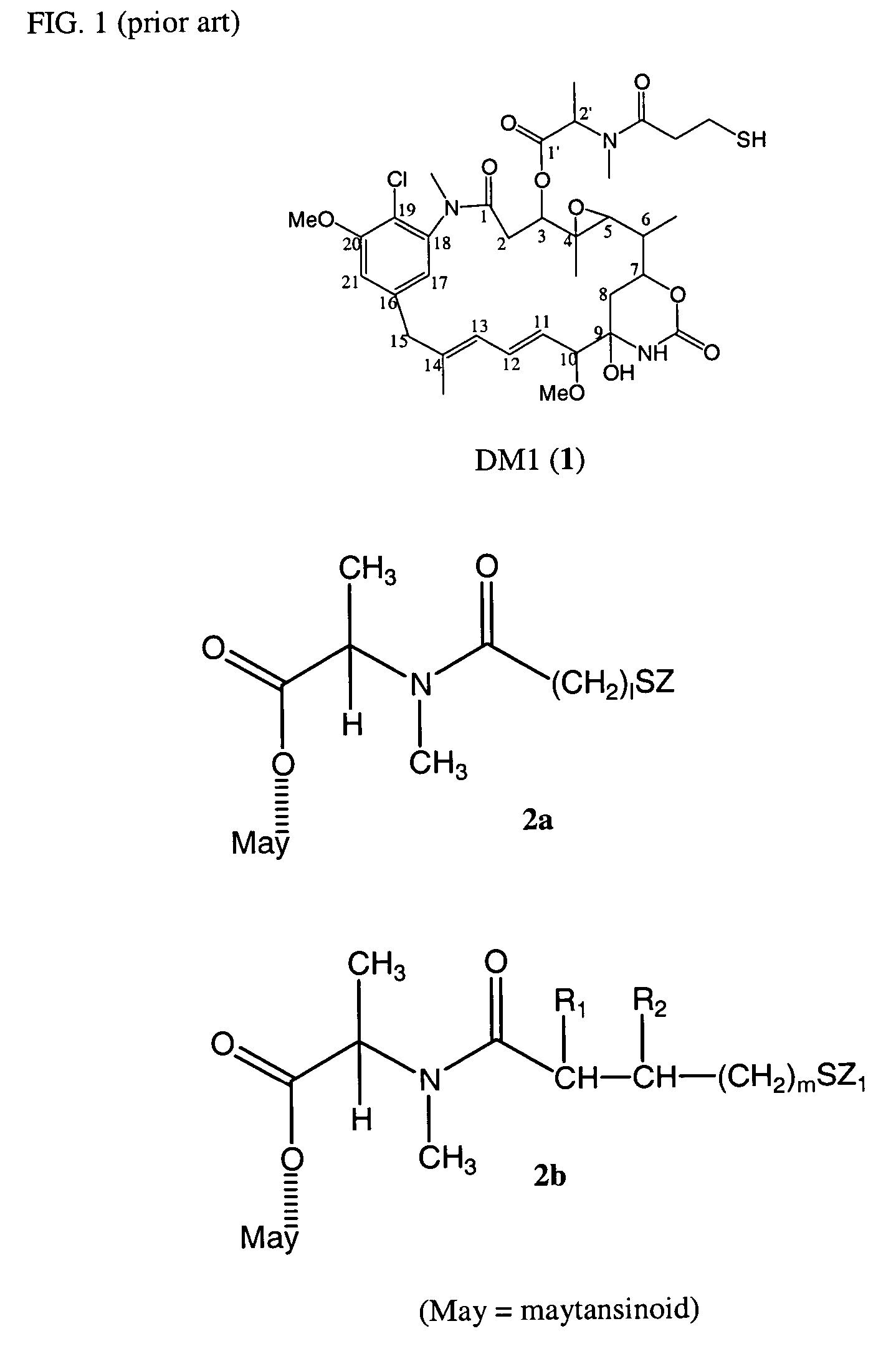Cytotoxic agents comprising new maytansinoids
a technology of cytotoxic agents and maytansinoids, which is applied in the direction of antibody medical ingredients, drug compositions, organic chemistry, etc., can solve the problems of ineffective mechanism by which drug molecules are released from antibodies, difficult chemical modification of existing drugs, and difficult to diminish the cytotoxic potential of existing drugs, etc., to achieve the effect of improving biological activity and vastly improving anti-tumor activity
- Summary
- Abstract
- Description
- Claims
- Application Information
AI Technical Summary
Benefits of technology
Problems solved by technology
Method used
Image
Examples
example 1
Synthesis of Maytansinoid 4b
[0458]4-Mercapto-4-methylpentanoic acid (7): A 500 mL flask was equipped with a stir bar and a 150 mL addition funnel. The system was placed under an argon atmosphere. 150 mL of anhydrous tetrahydrofurane (THBF) and 75 mL of 2.5 M n-BuLi in hexanes (18.7 mmol) were added via a canula and the solution was cooled in a −78° C. dry ice / acetone bath. Acetonitrile (7.3 g, 9.4 mL, 18 mmol) was added drop-wise via a syringe over approximately 5 min. The reaction was stirred for 30 min, while white lithium-acetonitrile precipitate was formed. Isobutylene sulfide (15 g, 17 mmol) was dissolved in 100 mL of anhydrous THF and added drop wise over approximately 30 min via the addition funnel. The cooling bath was removed and the reaction was allowed to stir for 3 hours. The flask was cooled in an ice / water bath as 38 mL of 0.5 M HCl was added drop-wise. The THF layer was retained and the aqueous layer was washed twice with 75 mL of ethyl acetate. The THF and ethyl acet...
example 2
Synthesis of Maytansinoid 4a
[0464]4-Methyldithio-pentanoic acid (13): A solution of 4-mercaptopentanoic acid (12, 16.6 g, 124 mmol) was dissolved in 350 mL of deionized water in a 500 mL flask. The solution was magnetically stirred as sodium carbonate (19.7 g, 186 mmol) was added to the acid at a rate that would not cause excessive frothing. The flask was equipped with a 250 mL addition funnel, which was charged with a solution of methyl methanethiolsulfonate (23.4 g, 186 mmol) dissolved in 220 mL of glass-distilled 100% ethanol. The flask was cooled in an ice / water bath and the system was maintained under an argon atmosphere. The methyl methanethiolsulfonate solution was added drop-wise to the flask as rapidly as possible but at such a speed as to prevent excessive frothing. The cooling bath was removed and the reaction mixture was allowed to stir for an additional 2 hours. Solvent was removed by rotary evaporation under vacuum, until approximately 250 mL remained. After which 30 m...
example 3
Synthesis of Maytansinoid 4g,h (FIG. 3c).
[0469]R-1,3-Di-O-p-toluenesulfonyl-butane (17): A solution of R-(−)-1,3-butanediol (16, 2.00 g, 22.22 mmol) in a mixture of dry pyridine (40 mL) and dry toluene (60 mL), was treated with p-toluenesulfonyl chloride (12.70 g, 66.84 mmol) under argon at 0° C. After stirring at 0° C. for 5 min. followed by stirring at room temperature for 2 h, the mixture was evaporated under vacuum, redissolved in ethyl acetate, and washed with 0.1 M aqueous NaHCO3, followed by saturated NaCl. The organic layer was dried over MgSO4, filtered, and the solvent was evaporated. Purification by chromatography on silica gel, eluting with 1:2 (v / v) ethyl acetate / hexane gave 6.51 g (74%) of the title product 17. Rf=0.40 (1:1 EtOAc / hexane); 1H NMR (CDCl3) 7.76 (dd, 4H, J=1.0, 8.0 Hz), 7.35 (dt, 4H, J=0.4, 8.0+8.0 Hz), 4.70 (m, 1H), 4.03 (m, 1H), 3.94 (m, 1H), 2.46 (s, 6H), 1.92 (m, 2H), 1.26 (d, 3H, J=6.3 Hz); 13C NMR 145.17, 133.00, 130.11, 128.12, 127.91, 76.28, 66.21,...
PUM
| Property | Measurement | Unit |
|---|---|---|
| concentrations | aaaaa | aaaaa |
| pH | aaaaa | aaaaa |
| pH | aaaaa | aaaaa |
Abstract
Description
Claims
Application Information
 Login to View More
Login to View More - R&D
- Intellectual Property
- Life Sciences
- Materials
- Tech Scout
- Unparalleled Data Quality
- Higher Quality Content
- 60% Fewer Hallucinations
Browse by: Latest US Patents, China's latest patents, Technical Efficacy Thesaurus, Application Domain, Technology Topic, Popular Technical Reports.
© 2025 PatSnap. All rights reserved.Legal|Privacy policy|Modern Slavery Act Transparency Statement|Sitemap|About US| Contact US: help@patsnap.com



